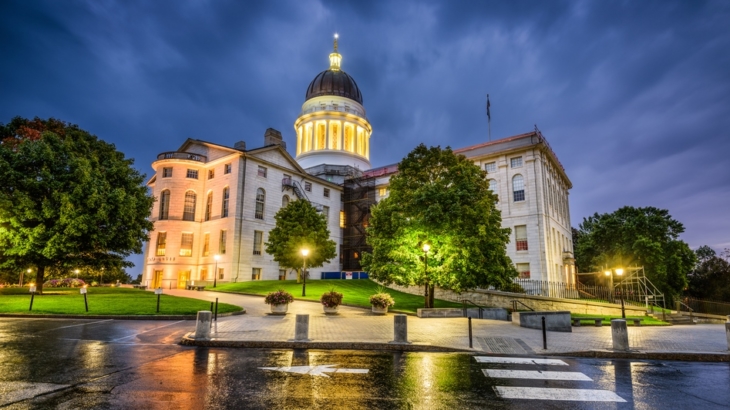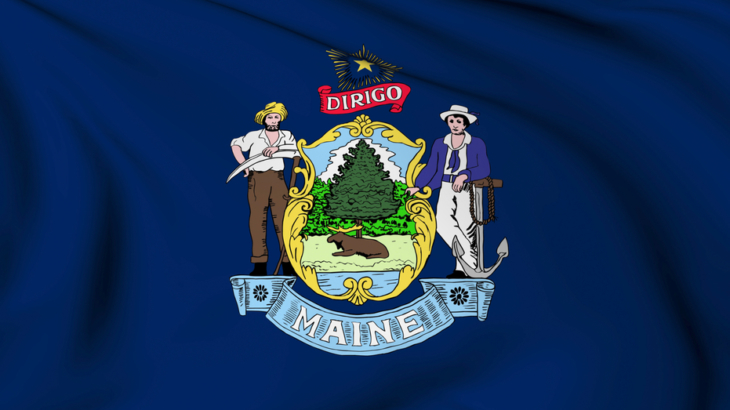LISTEN ON SOUNDCLOUD:
The Maine Event: The Crisis and Its Outcome
The young United States was expanding, and by 1819 had grown to 21 states from the original 13 with more territories lining up to get in thanks to the Louisiana Purchase. But this raised serious political problems. The thorny slavery issue darkened much of American political discourse and policy in the early post-independence years. A precarious balance of power in Congress between slave-holding and free states prevailed until December 1819, when pro-slavery Alabama was admitted to the Union as the 22nd state.
Missouri, carved from the Louisiana Purchase, came knocking next seeking statehood but its application ignited an enormous constitutional crisis which quickly involved Maine. In November 1818, the Missouri territorial legislature passed legislation requesting statehood and transmitted it to the U.S. Congress in December. What should have been a no-brainer for admission became bogged down in controversy over the precarious balance between slave and free states. Missouri intended to permit slavery, which prompted free-state legislators to attach “killer” amendments to the Missouri statehood bill that stalled it. Chaos and uproar ensued in Washington.
Along came Maine, where separation sentiment was growing. Many previous efforts to permit Maine to break away died in the Massachusetts General Court (legislature). But the times were catching up. Seeking to eliminate its Revolutionary War debt to the U.S. government, Massachusetts found easy money by selling off vast swaths of public land in Maine and by granting generous acreages to war veterans. Thousands of pioneer families left the crowded Bay State and trekked to the Maine wilderness seeking elbow room and new opportunities. In less than 30 years, the population more than tripled, from 91,000 in 1791 to 300,000 by 1820.
As Maine grew, so did discontent with its political and economic dependence on Massachusetts. Prosperous coastal merchants, eager to govern themselves, were the first to complain. But with continued population growth outside the old coastal towns, frustration spread to fishermen and inland farmers and woodsmen, who had little in common with the governing gentry. By 1800, they were spearheading the quest for statehood, citing a long list of economic and political grievances. The War of 1812 was the final nail in the coffin, even for the merchant class.
At last, in the summer of 1819, Mainers voted so overwhelmingly–nearly ¾ of the electorate– for statehood that Massachusetts could no longer turn a blind eye. The legislature reluctantly adopted a statehood bill for Maine in late 1819, but with one proviso: if statehood was not approved by Congress and signed by the President by March 4, 1820, Maine would remain tethered to Massachusetts.
The Maine statehood bill came up in Congress in December of 1819, mere weeks after Missouri’s bid. Maine’s application offered the possibility of a compromise. To maintain the free-state/slave-state balance, Congressional leaders pushed the two requests for statehood as a package — one new slave and one new free state. Maine suddenly found itself in the midst of a firestorm of controversy.
Abolitionists all over the Union erupted. They were firmly opposed to the admission of any new slave states. Pro-slavery interests were equally as upset. Many Mainers, most of them ardent abolitionists, were torn. To prevent the spread of slavery, they found themselves calling for the defeat of the very bill that would have granted them long-sought statehood. The most distinguished Maine native in the country was Rufus King. Born and raised in Scarborough, scion of a wealthy family, he had a noteworthy political career. A Signer of the U.S. Constitution, he was twice the Federalist Party candidate for President and was a U.S. Senator from New York at the time of the Maine-Missouri imbroglio. With a heavy heart, he opposed the Maine statehood measure because, as he correctly foresaw, the “compromise” didn’t settle the slavery issue, but merely postponed a final day of reckoning. Meanwhile, his half-brother, William King, principal author of Maine’s constitution, was elected Maine’s first Governor.
At the last minute, the bill for Maine statehood passed Congress; on March 3, 1820, and signed into law, taking effect on March 15. Maine became our 23rd state. Missouri joined the Union as a slave state in 1821. The so-called Missouri Compromise had severely tested several key articles and amendments in the U.S. Constitution during tense, angry debates. In a long letter on April 22, 1820, to his friend and political associate John Holmes, who became one of Maine’s first two U.S. Senators, the aging Thomas Jefferson wrote:
“… this momentous question, like a fire bell in the night, awakened and filled me with terror. I considered it at once as the knell of the Union. It is hushed indeed for the moment. But this is a reprieve only, not a final sentence.”
Like the venerable Rufus King, Jefferson perceived that the Missouri Compromise represented “a reprieve only, not a final sentence.” That “final sentence” would come through all-out war 40 years later.
Maine’s Constitution
The Maine Constitution is the fourth-oldest operating state constitution in the country. The 210 delegates to the statehood convention in October 1819 unanimously adopted the proposed state constitution, which is modeled closely on the U.S. Constitution. Notable contents:
- Article I contains 24 sections, the longest of which (Section 3) painstakingly spells out provisions regarding religious liberty.
- Thomas Jefferson authored Sections 1 and 2 of Article VIII addressing education.
- Article I, Section 6-A is one of the earliest official codifications in the U.S. of non-discrimination against all persons without exception.
- Article I, Section 16 is among the most explicit defenses of the right to keep and bear arms ever written: “Every citizen has a right to keep and bear arms and this right shall never be questioned.”
- Article II, Section 1 specifically grants Native Americans “residing on tribal reservations and otherwise qualified” the right to vote in all elections.
In 2015, controversy erupted when a Maliseet Tribe delegate to the Maine Legislature sought to overturn a 19th Century ban on printing the text of Article X, Section 5, which defines the state’s obligations to Native American tribes via carryover provisions from Massachusetts.
The Constitution of Maine is updated as necessary by the Revisor of Statutes upon ratification of amendments by the voters of the state. The Constitution of Maine is subject to recodification every 10 years by its own terms (Article X, Section 6). The last recodification was in 2013.
Additional Maine History
- Printed flat maps show Maine as extremely high north. In truth, seven U.S. states extend farther north in whole or part than Maine. True globes confirm that Maine is much more easterly than northerly. Portland is the closest key seaport to Europe by a factor of hundreds of miles, as is Bangor International Airport (a former B-52 bomber base) for air traffic. The easternmost point in the U.S. is, oddly enough, West Quoddy Head in Lubec, Maine.
- The legendary political axiom “As Maine goes, so goes the nation” stems from the fact that Maine once held its general elections in September rather than November, on the sensible reasoning that snow could be flying by then. In September 1840, Maine elected a Whig Party governor. That November, Whig candidate William Henry Harrison was elected President. That launched the saying of Maine as a political bellwether, which held true roughly 70% of the time up through the late 1920s. Maine amended its constitution in 1957 to conform to the rest of the country and held elections in November effective in 1960.
- The baseball term signifying the batting order–“At bat, on deck, and in the hole”—originated in Belfast, Maine, in 1872. It was confirmed personally by Paul Dickson, author of the authoritative, widely cited Dickson Baseball Dictionary, based on his original research in Belfast in 1987. A 1938 Sporting News feature published recollections of an aged member of the Belfast Pastimes, who played a traveling Boston pro team on August 7, 1872, in Belfast. Team scorekeepers back then would shout the batting order each inning. Boston’s man simply bellowed the names. But the Belfast man announced “Smith at bat, Jones on deck (or ‘on the deck’), and Doe in the hold,” reflecting Belfast’s maritime roots, the hold being the below-deck storage area on a commercial vessel. The Bostonians took a fancy to the designation and popularized it. Over time, “hold” slurred into “hole.”
The original score sheet from that game is on display at the Belfast Historical Society Museum.
- Why is Maine often referred to as “Down East?” It’s a nautical term. In warm weather, prevailing winds in New England and Maritime Canada come out of the southwest, meaning ships headed there sailed downwind. Conversely, when en route to Boston, New York, or other lower locales, sailors dealt with upwinds. To this day, many Mainers speak of going “up to Boston.” The area known as Down East is most commonly the territory east of the Penobscot River and sometimes includes Canada’s Maritime provinces.
- In mid-coast Maine, the town of Searsport, never home to more than 2,500 residents, once boasted 17 shipyards and in the 1870s was home to fully one-tenth of all American merchant sea captains.
- The first international telephone call took place July 1, 1881, between St. Stephen, New Brunswick, Canada, and Calais, Maine, USA. For generations, Calais and St. Stephen have enjoyed close relations. One example stems from the War of 1812, when the British military supplied St. Stephen with a large supply of gunpowder for protection against the Yankee enemy in Calais. Instead, St. Stephen’s leaders donated much of it to Calais so it could enjoy a proper boom-and-bang Independence Day celebration.
Jeffrey Hollingsworth grew up in Belfast, Maine, and is a University of Maine alumnus. He is a past president of the Maine State Society of Washington, D.C., and principal founder of its charitable foundation. He is the author of Magnificent Mainers (Covered Bridge Press), a compendium of mini-biographies of 100 famous Maine natives. His articles have appeared in Honolulu and Down East magazines and in the Las Vegas Review-Journal, Portland Press Herald, and other periodicals.
Click Here to have the NEWEST essay in this study emailed to your inbox every day!
Click Here to view the schedule of topics in our 90 Day Study on Congress.


